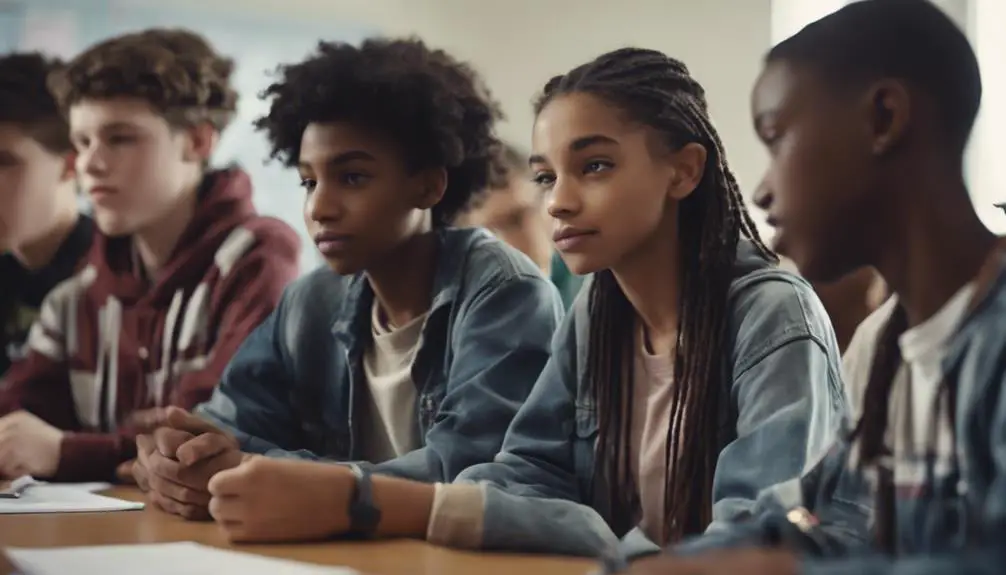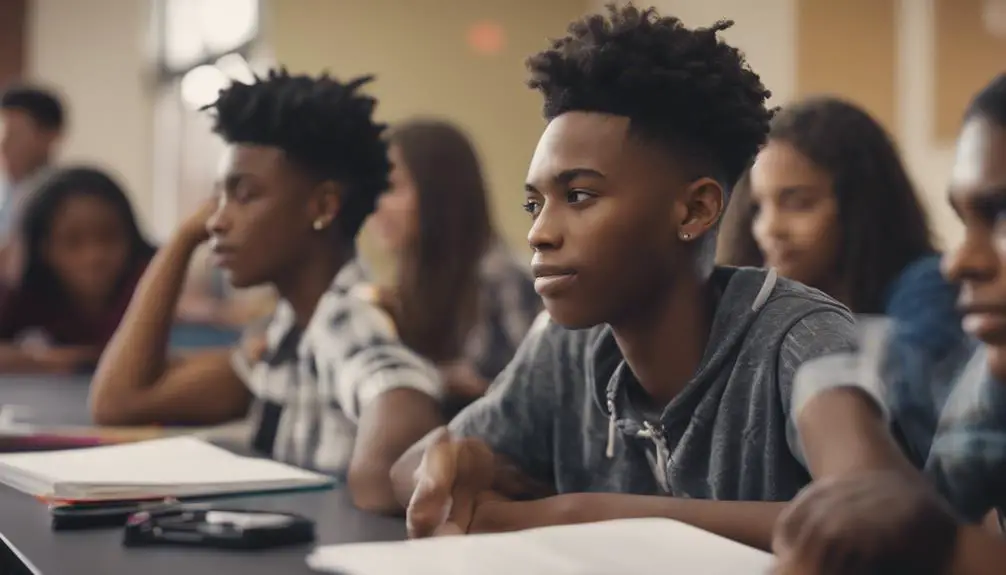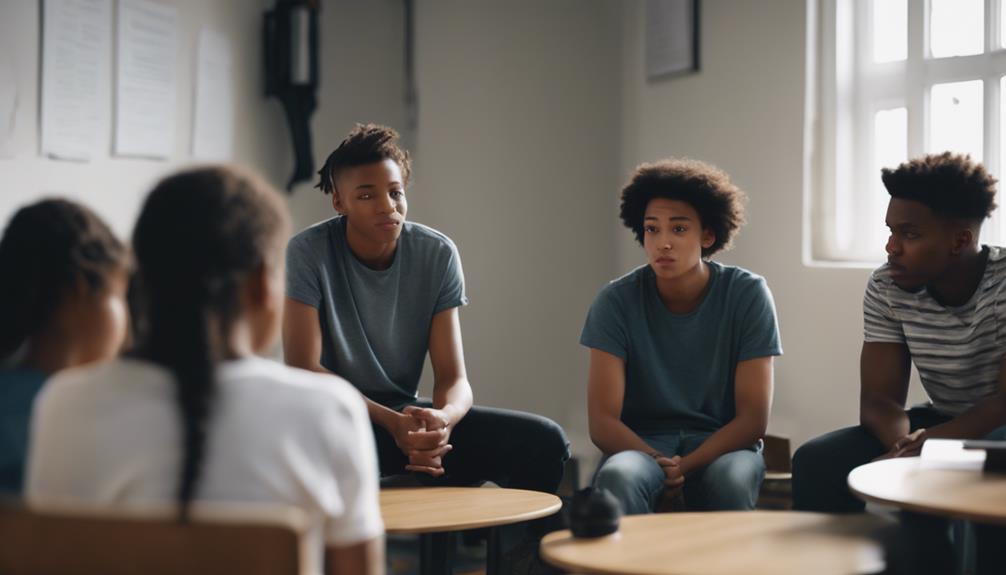As I enter the classroom, the clock on the wall reminds me of the importance of consequences. They serve as a guide, helping students develop responsible behavior and shape their character.
But why do classrooms need consequences? It’s not just about punishment or control. Consequences play a crucial role in managing behavior, promoting accountability, and teaching valuable life lessons.
So, let’s delve into the reasons why consequences are necessary in the classroom and how they contribute to personal growth and development.
Why Classrooms Need Consequences
Classrooms require consequences for several important reasons.
First, implementing strategies to manage behavior helps maintain order and create a positive learning environment.
Second, consequences foster accountability and responsibility among students, teaching them the significance of their actions.
Lastly, consequences impart the understanding of cause and effect to students, enabling them to recognize the impact of their choices and encouraging the development of self-discipline.
Behavior Management Strategies
Maintaining a positive and productive learning environment in the classroom requires consequences. As an educator, it’s my responsibility to implement effective strategies that promote respect and support.
One important approach is using positive reinforcement to acknowledge and reward desired behaviors, encouraging students to continue making good choices.
Proactive strategies, like establishing clear rules and expectations, help set the stage for appropriate behavior from the beginning.
Techniques for modifying behavior can be used to address and change challenging behaviors, allowing students to learn and grow from their mistakes.
Conflict resolution skills are also crucial for fostering a harmonious classroom, empowering students to resolve conflicts peacefully and respectfully.
Promote Accountability and Responsibility
Creating a classroom environment that promotes accountability and responsibility requires clear expectations and consequences for students’ actions. By establishing these guidelines, we can foster accountability and develop responsibility in our students.
When students understand what’s expected of them and the potential consequences of their actions, they become more conscious of the impact they have on themselves and others. This awareness cultivates independence as they learn to make better decisions.
Consistently implementing consequences also helps our students develop self-awareness as they reflect on their choices and the outcomes that result from them. This process enhances their decision-making skills, enabling them to become responsible and accountable individuals.
Ultimately, our goal is to cultivate a learning environment where students recognize the significance of their choices and take ownership of their actions, leading to a positive and productive classroom.
Teach Cause and Effect
Teaching cause and effect in the classroom is important for students to understand how their actions can have an impact.
By teaching discipline and consequences in a clear and straightforward manner, we can help students develop a sense of responsibility and accountability.
While some students may already be familiar with consequences at home, it’s crucial to reinforce these concepts in the classroom.
By implementing behavior consequences, students can learn from their mistakes and experience the natural outcomes of their actions.
It’s also important to use positive reinforcement to motivate and encourage desired behaviors.
Encourage Self-Discipline
As an educator, I firmly believe that promoting self-discipline in the classroom is crucial for creating a positive learning environment and preparing students for success in the real world.
To foster self-control, it’s essential to teach discipline and cultivate responsibility in students. By establishing clear expectations and enforcing consequences, we can help students understand the importance of following rules and taking ownership of their actions.
Encouraging self-discipline also promotes independence, as students learn to make responsible choices and regulate their behavior. It’s our duty as educators to develop self-regulation skills in our students, empowering them to effectively manage their emotions and actions.
Maintain a Positive Environment
Maintaining a positive classroom environment requires implementing consequences. By using positive reinforcement and effective discipline strategies, teachers can create a classroom culture that promotes student engagement and meets behavior expectations.
Here are three key ways to maintain a positive environment:
- Set clear behavior expectations: Clearly communicate the rules and expectations to students. This helps create a structured and safe environment where students understand what’s expected of them.
- Use positive reinforcement: Recognize and reward students for their positive behavior. This encourages them to continue demonstrating good behavior and fosters a positive classroom culture.
- Address misbehavior promptly and consistently: When misbehavior occurs, address it promptly and consistently. This helps students understand the consequences of their actions and reinforces the importance of following the behavior expectations.
Foster a Sense of Fairness
Maintaining a positive classroom environment requires fostering a sense of fairness by implementing consequences. This promotes justice and equality, encourages empathy, develops critical thinking skills, and teaches conflict resolution to students. It’s essential to create a classroom where everyone feels heard and valued. To achieve this, consequences must be fair and consistent, ensuring that every student understands the expectations and consequences of their actions.
Let’s examine the benefits of fostering fairness in the classroom:
- Promotes justice
- Encourages empathy
- Develops critical thinking
Develop Social Skills
Consequences play a vital role in developing students’ social skills in the classroom. By implementing consequences, we create an environment where students can learn and grow both academically and socially. Here are three reasons why consequences are crucial for social skill development:
- Develop Empathy: When students face consequences for their actions, they gain an understanding of how their behavior impacts others. This helps them develop empathy and consider the feelings and perspectives of their peers.
- Practice Cooperation: Consequences provide opportunities for students to collaborate and practice cooperation. They learn to compromise, share responsibilities, and work together towards a common goal.
- Improve Communication and Conflict Resolution: Consequences teach students the importance of effective communication and problem-solving. They learn to express themselves respectfully, actively listen, and find solutions to conflicts, fostering strong relationships along the way.
Enhance Learning Outcomes
Implementing consequences in the classroom is crucial for enhancing learning outcomes. Consequences are powerful tools for modifying behavior and can have a positive impact on various aspects of a student’s education journey.
Consequences encourage students to take responsibility for their actions, enhance problem-solving skills and critical thinking abilities, and improve focus and attention to detail. They also foster self-discipline and self-regulation, promote creativity and innovation, and increase knowledge retention.
Additionally, consequences help develop a growth mindset and a love for learning, cultivate perseverance and resilience, and boost grades and test scores.
Prepare for Real-World Consequences
As an educator, I believe that implementing consequences in the classroom is crucial for preparing students to face real-world outcomes. By experiencing real-life consequences within the safe environment of the classroom, students are better equipped to develop critical thinking and decision-making skills that will serve them well in the future.
Here are three reasons why preparing students for real-world consequences is vital:
- Developing critical thinking: When students face consequences for their actions, they’re encouraged to analyze the situation, consider alternative choices, and evaluate the potential outcomes. This fosters critical thinking skills that are essential for navigating real-world scenarios.
- Understanding long-term consequences: Classroom consequences allow students to understand that their actions can have long-term effects. This helps them develop the ability to think beyond immediate gratification and make decisions that consider the potential long-term consequences.
- Applying lessons to real-world scenarios: By experiencing consequences in the classroom, students can practice applying the lessons they learn to real-world situations. This prepares them to make informed choices and take responsibility for their actions when faced with similar scenarios outside of the classroom.
Build Character and Values
Implementing consequences in the classroom is crucial for shaping students’ character and values. By holding students accountable for their actions, we can build character and instill important values that will guide them throughout their lives.
Consequences provide opportunities for personal growth, teaching students to take responsibility for their choices and actions. Through experiencing consequences, students learn the importance of honesty, integrity, and respect for themselves and others.
Moreover, consequences also help develop social skills, as students learn to navigate conflicts and make amends for their mistakes. Additionally, consequences encourage problem-solving skills, as students learn to think critically and find solutions to the challenges they face.
Establish Boundaries and Expectations
Establishing clear boundaries and expectations in the classroom is crucial for creating a structured learning environment where consequences can be effectively enforced. When it comes to classroom management, setting expectations and behavior guidelines helps students understand what’s acceptable and what’s not.
Here are three reasons why establishing boundaries and expectations is important:
- Promotes a sense of safety and security: By clearly defining the rules and expectations, students feel safe and know what’s expected of them, creating a conducive learning environment.
- Fosters responsibility and accountability: When students understand the boundaries, they’re more likely to take responsibility for their actions and be accountable for their behavior.
- Enables consistent disciplinary measures: With clear guidelines, teachers can apply disciplinary measures consistently, ensuring fairness and promoting a sense of justice in the classroom.
Teach Problem-Solving Skills
Establishing clear boundaries and expectations in the classroom is important. Equally important is teaching problem-solving skills to students.
By teaching problem-solving, critical thinking, decision making, conflict resolution, and teamwork, students are equipped with the necessary tools to navigate challenges and find solutions. These skills empower students to think critically, analyze situations, and make informed decisions. They learn to resolve conflicts peacefully and collaborate with others to achieve common goals.
In a classroom setting, this promotes a positive and respectful learning environment and cultivates a sense of responsibility and accountability among students.
Encourage Personal Growth
Consequences are crucial in the classroom for promoting personal growth and development in students. By encouraging self-reflection, instilling perseverance, and cultivating resilience, consequences provide the necessary tools for students to develop a growth mindset and become self-aware individuals.
- Promoting self-reflection: Consequences help students pause and think about their actions, allowing them to understand the impact of their choices on themselves and others. This self-reflection fosters personal growth and encourages students to take responsibility for their behavior.
- Instilling perseverance: Consequences teach students the importance of resilience and persistence. When faced with challenges or setbacks, students learn to keep going and find solutions instead of giving up. This cultivates resilience, a valuable trait for personal growth.
- Fostering a growth mindset: Consequences provide opportunities for students to learn from their mistakes and grow. By understanding that failure isn’t permanent but rather a stepping stone towards improvement, students develop a growth mindset that fuels personal growth.
Implementing effective consequences in the classroom is essential for nurturing personal growth and empowering students to become their best selves.
Conclusion
Consequences are essential in classrooms. They guide students towards responsible behavior, creating a positive learning environment.
Just like pruning is necessary for a garden to flourish, students need consequences to develop essential life skills.
Effective implementation of consequences empowers educators to cultivate a fruitful educational experience, preparing students to confidently tackle future challenges.

















